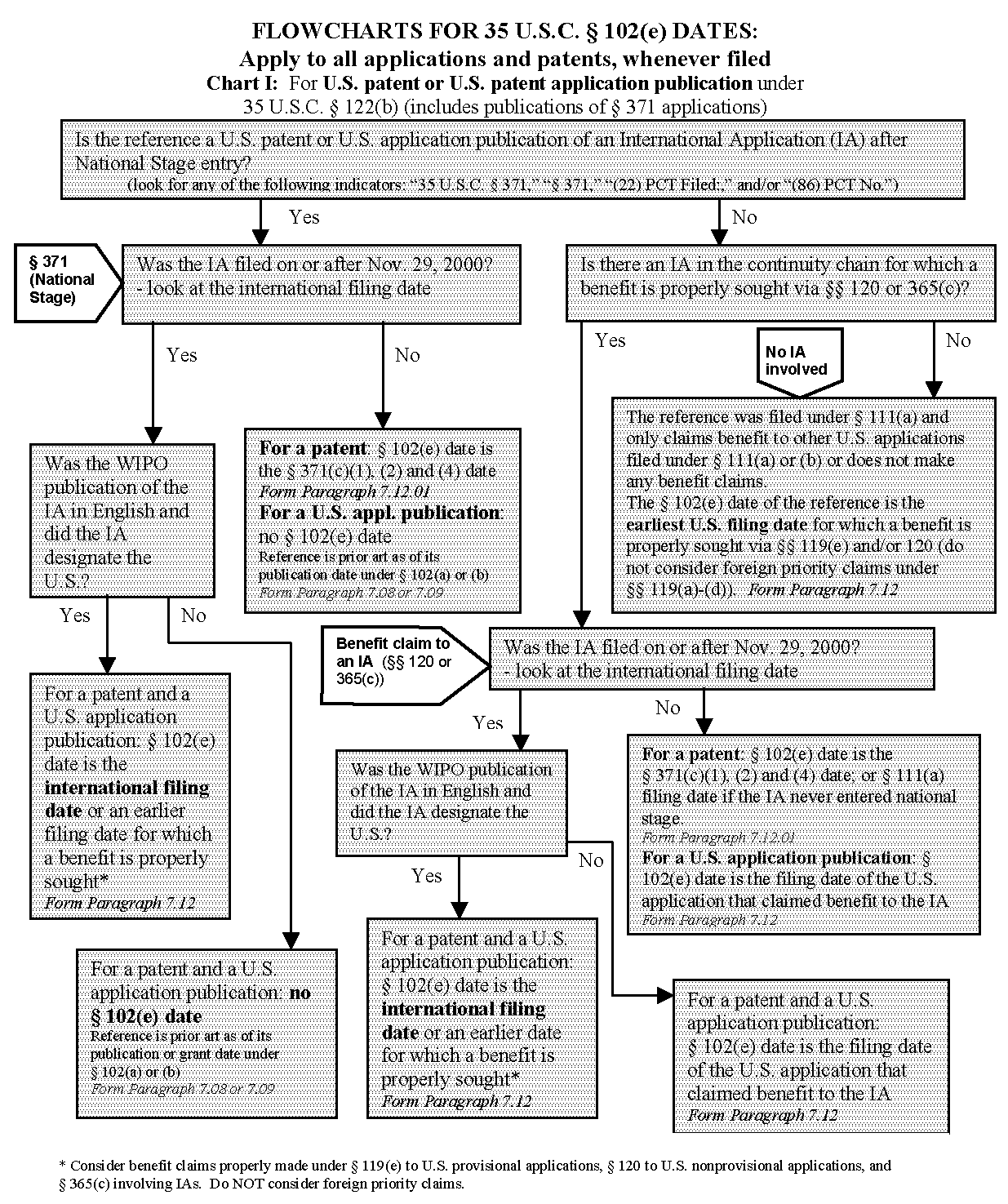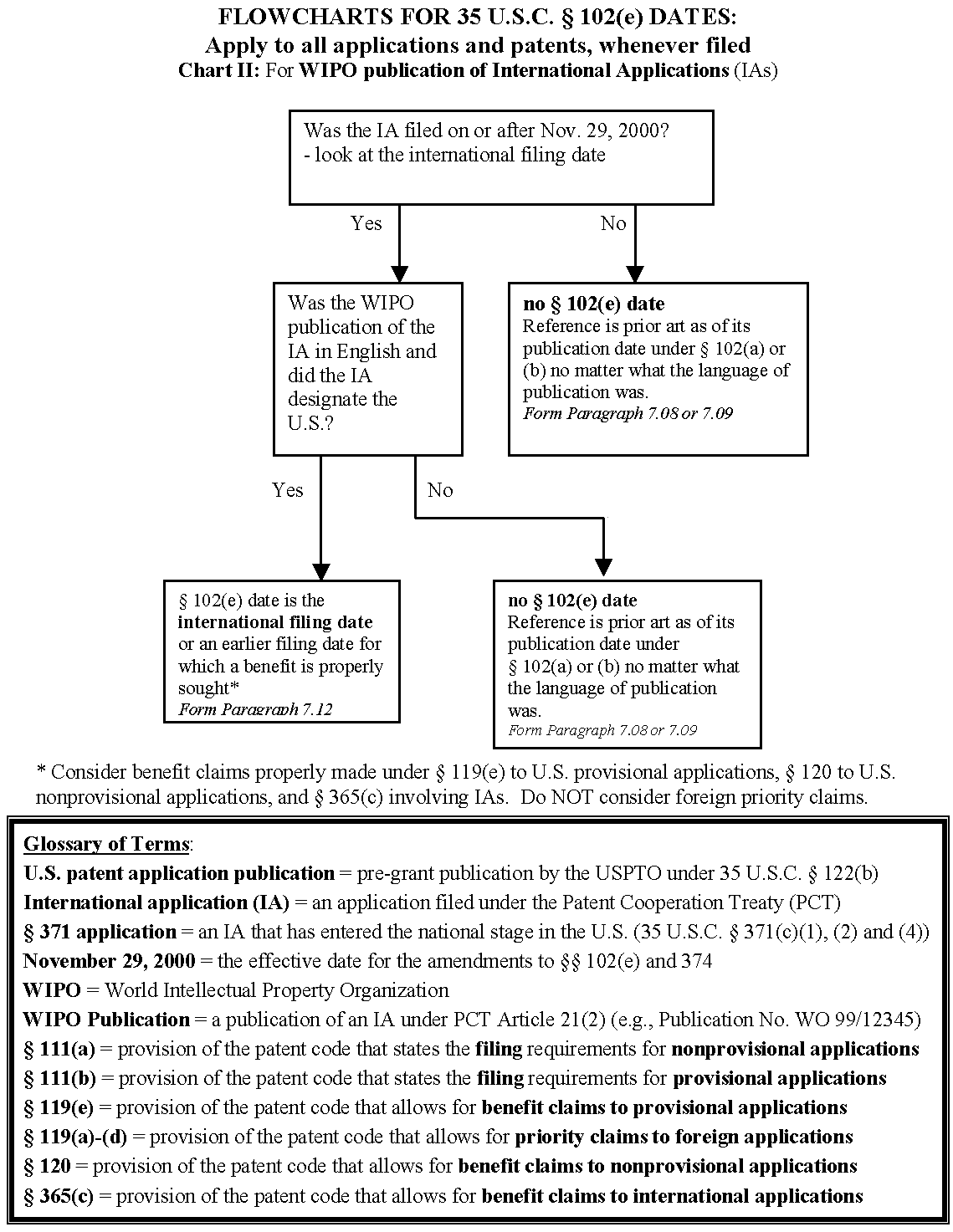Notice regarding Section 508 of the Workforce Investment Act of 1998. Section 508 of the Workforce Investment Act of 1998 requires all United States Federal Agencies with websites to make them accessible to individuals with disabilities. At this time, the MPEP files below do not meet all standards for web accessibility. Until changes can be made to make them fully accessible to individuals with disabilities, the USPTO is providing access assistance via telephone. MPEP Interim Accessibility Contact: 571-272-8813.
706.02(f)(1) Examination Guidelines for Applying References Under 35 U.S.C. 102(e) [R-5] - 700 Examination of Applications
706.02(f)(1) Examination Guidelines for Applying References Under 35 U.S.C. 102(e) [R-5]
I. DETERMINE THE APPROPRIATE 35 U.S.C. 102(e) DATE FOR EACH POTENTIAL REFERENCE BY FOLLOWING THE GUIDELINES, EXAMPLES, AND FLOW CHARTS SET FORTH BELOW:
(A) The potential reference must be a U.S. patent, a U.S. application publication ( 35 U.S.C. 122(b)) or a WIPO publication of an international application under PCT Article 21(2) in order to apply the reference under 35 U.S.C. 102(e).
(B) Determine if the potential reference resulted from, or claimed the benefit of, an international application. If the reference does, go to step (C) below. The 35 U.S.C. 102(e) date of a reference that did not result from, nor claimed the benefit of, an international application is its earliest effective U.S. filing date, taking into consideration any proper benefit claims to prior U.S. applications under 35 U.S.C. 119(e) or 120 if the prior application(s) properly supports the subject matter used to make the rejection in compliance with 35 U.S.C. 112, first paragraph. See MPEP § 2136.02.
(C) If the potential reference resulted from, or claimed the benefit of, an international application, the following must be determined:
(1) If the international application meets the following three conditions:
(a) an international filing date on or after November 29, 2000;
(b) designated the United States; and
(c) published under PCT Article 21(2) in English,
then the international filing date is a U.S. filing date for prior art purposes under 35 U.S.C. 102(e). If such an international application properly claims benefit to an earlier-filed U.S. or international application, or to an earlier-filed U.S. provisional application, apply the reference under 35 U.S.C. 102(e) as of the earlier filing date, assuming all the conditions of 35 U.S.C. 102(e), 119(e), 120, or 365(c) are met. The subject matter used in the rejection must be disclosed in the earlier-filed application in compliance with 35 U.S.C. 112, first paragraph, in order for that subject matter to be entitled to the earlier filing date under 35 U.S.C. 102(e). Note, where the earlier application is an international application, the earlier international application must satisfy the same three conditions (i.e., filed on or after November 29, 2000, designated the U.S., and had been published in English under PCT Article 21(2)) for the earlier international filing date to be a U.S. filing date for prior art purposes under 35 U.S.C. 102(e).(2) If the international application was filed on or after November 29, 2000, but did not designate the United States or was not published in English under PCT Article 21(2), do not treat the international filing date as a U.S. filing date for prior art purposes. In this situation, do not apply the reference as of its international filing date, its date of completion of the 35 U.S.C. 371(c)(1), (2) and (4) requirements, or any earlier filing date to which such an international application claims benefit or priority. The reference may be applied under 35 U.S.C. 102(a) or (b) as of its publication date, or 35 U.S.C. 102(e) as of any later U.S. filing date of an application that properly claimed the benefit of the international application (if applicable).
(3) If the international application has an international filing date prior to November 29, 2000, apply the reference under the provisions of 35 U.S.C. 102 and 374, prior to the AIPA amendments:
(a) For U.S. patents, apply the reference under 35 U.S.C. 102(e) as of the earlier of the date of completion of the requirements of 35 U.S.C. 371(c)(1), (2) and (4) or the filing date of the later-filed U.S. application that claimed the benefit of the international application;
(b) For U.S. application publications and WIPO publications directly resulting from international applications under PCT Article 21(2), never apply these references under 35 U.S.C. 102(e). These references may be applied as of their publication dates under 35 U.S.C. 102(a) or (b);
(c) For U.S. application publications of applications that claim the benefit under 35 U.S.C. 120 or 365(c) of an international application filed prior to November 29, 2000, apply the reference under 35 U.S.C. 102(e) as of the actual filing date of the later-filed U.S. application that claimed the benefit of the international application.
(4) Examiners should be aware that although a publication of, or a U.S. Patent issued from, an international application may not have a 35 U.S.C. 102(e) date at all, or may have a 35 U.S.C. 102(e) date that is after the effective filing date of the application being examined (so it is not "prior art"), the corresponding WIPO publication of an international application may have an earlier 35 U.S.C. 102(a) or (b) date.
(D) Foreign applications' filing dates that are claimed (via 35 U.S.C. 119(a)-(d), (f), or 365(a) or (b)) in applications, which have been published as U.S. or WIPO application publications or patented in the U.S., may not be used as 35 U.S.C. 102(e) dates for prior art purposes. This includes international filing dates claimed as foreign priority dates under 35 U.S.C. 365(a) or (b).
II. EXAMPLES
In order to illustrate the prior art dates of U.S. and WIPO publications of patent applications and U.S. patents under 35 U.S.C. 102(e), nine examples are presented below. The examples only cover the most common factual situations that might be encountered when determining the 35 U.S.C. 102(e) date of a reference. Examples 1 and 2 involve only U.S. application publications and U.S. patents. Example 3 involves a priority claim to a foreign patent application. Examples 4-9 involve international applications. The time lines in the examples below show the history of the prior art references that could be applied against the claims of the application under examination, or the patent under reexamination.
The examples only show the information necessary to determine a prior art date under 35 U.S.C. 102(e). Also, the dates in the examples below are arbitrarily used and are presented for illustrative purposes only. Therefore, correlation of patent grant dates with Tuesdays or application publication dates with Thursdays may not be portrayed in the examples.
| Example 1 : Reference Publication and Patent of 35 U.S.C. 111 (a) Application with no Priority/Benefit Claims. |
| For reference publications and patents of patent applications filed under 35 U.S.C. 111 (a) with no claim for the benefit of, or priority to, a prior application, the prior art dates under 35 U.S.C. 102 (e) accorded to these references are the earliest effective U.S. filing dates. Thus, a publication and patent of a 35 U.S.C. 111 (a) application, which does not claim any benefit under either 35 U.S.C. 119 (e), 120 or 365(c), would be accorded the application's actual filing date as its prior art date under 35 U.S.C. 102 (e). |

The 35 U.S.C. 102(e)(1) date for the Publication is 08 Dec. 2000. The 35 U.S.C. 102(e)(2) date for the Patent is: 08 Dec. 2000.
| Example 2 : Reference Publication and Patent of 35 U.S.C. 111 (a) Application with * > a < Benefit Claim to a Prior U.S. Provisional or Nonprovisional Application. |
| For reference publications and patents of patent applications filed under 35 U.S.C. 111 (a), the prior art dates under 35 U.S.C. 102 (e) accorded to these references are the earliest effective U.S. filing dates. Thus, a publication and patent of a 35 U.S.C. 111 (a) application, which claims * > benefit < under 35 U.S.C. 119 (e) to a prior U.S. provisional application or claims the benefit under 35 U.S.C. 120 of a prior nonprovisional application, would be accorded the earlier filing date as its prior art date under 35 U.S.C. 102 (e), assuming the earlier-filed application has proper support for the subject matter as required by 35 U.S.C. 119 (e) or 120. |
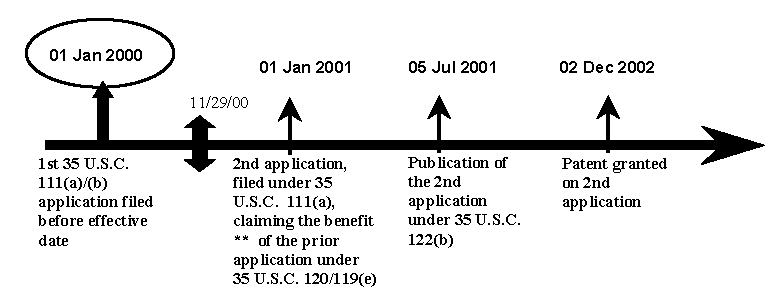
The 35 U.S.C. 102(e)(1) date for the Publication is: 01 Jan. 2000. The 35 U.S.C. 102(e)(2) date for the Patent is: 01 Jan. 2000.
| Example 3 : Reference Publication and Patent of 35 U.S.C. 111 (a) Application with 35 U.S.C. 119 (a)-(d) * > Priority < Claim to a Prior Foreign Application. |
| For reference publications and patents of patent applications filed under 35 U.S.C. 111 (a), the prior art dates under 35 U.S.C. 102 (e) accorded to these references are the earliest effective U.S. filing dates. No benefit of the filing date of the foreign application is given under 35 U.S.C. 102 (e) for prior art purposes ( In re Hilmer , 149 USPQ 480 (CCPA 1966)). Thus, a publication and patent of a 35 U.S.C. 111 (a) application, which claims * > priority < under 35 U.S.C. 119 (a)-(d) to a prior foreign-filed application (or under 35 U.S.C. 365 (a) to an international application), would be accorded its U.S. filing date as its prior art date under 35 U.S.C. 102 (e). In the example below, it is assumed that the earlier-filed U.S. application has proper support for the subject matter of the later-filed U.S. application as required by 35 U.S.C. 120 . |

The 35 U.S.C. 102(e)(1) date for the Publication is: 21 June 1999. The 35 U.S.C. 102(e)(2) date for the Patent is: 21 June 1999.
| Example 4 : References based on the national stage ( 35 U.S.C. 371 ) of an International Application filed on or after November 29, 2000 and which was published in English under PCT Article 21(2) . |
| All references, whether the WIPO publication, the U.S. patent application publication or the U.S. patent, of an international application (IA) that was filed on or after November 29, 2000, designated the U.S., and was published in English under PCT Article 21(2) by WIPO have the 35 U.S.C. 102 (e) prior art date of the international filing date or earlier effective U.S. filing date. No benefit of the international filing date (nor any U.S. filing dates prior to the IA), however, is given for 35 U.S.C. 102 (e) prior art purposes if the IA was published under PCT Article 21(2) in a language other than English. |

The 35 U.S.C. 102(e)(1) date for the IA Publication by WIPO is: 01 Jan. 2001. The 35 U.S.C. 102(e)(1) date for the Publication by USPTO is: 01 Jan. 2001. The 35 U.S.C. 102(e)(2) date for the Patent is: 01 Jan. 2001.
| Additional * Benefit Claims : |
| If a later-filed U.S. nonprovisional ( 35 U.S.C. 111 (a)) application claimed the benefit of the IA in the example above, the 35 U.S.C. 102 (e) date of the patent or publication of the later-filed U.S. application would be the international filing date, assuming the earlier-filed IA has proper support for the subject matter relied upon as required by 35 U.S.C. 120 . |
| If the IA properly claimed ** > the benefit of < an earlier-filed U.S. provisional ( 35 U.S.C. 111 (b)) application or the benefit of an earlier-filed U.S. nonprovisional ( 35 U.S.C. 111 (a)) application, the 35 U.S.C. 102 (e) date for all the references would be the filing date of the earlier-filed U.S. application, assuming the earlier-filed application has proper support for the subject matter relied upon as required by 35 U.S.C. 119 (e) or 120. |
| Example 5 : References based on the national stage ( 35 U.S.C. 371 ) of an International Application filed on or after November 29, 2000 and which was not published in English under PCT Article 21(2) . |
|
All references, whether the WIPO publication, the U.S. patent application publication or the U.S. patent, of an international application (IA) that was filed on or after November 29, 2000 but was not published in English under PCT Article 21(2) have no 35 U.S.C. 102 (e) prior art date at all. According to 35 U.S.C. 102 (e), no benefit of the international filing date (nor any U.S. filing dates prior to the IA) is given for 35 U.S.C. 102 (e) prior art purposes if the IA was published under PCT Article 21(2) in a language other than English, regardless of whether the international application entered the national stage. Such references may be applied under 35 U.S.C. 102 (a) or (b) as of their publication dates, but never under 35 U.S.C. 102 (e). |

The 35 U.S.C. 102(e)(1) date for the IA Publication by WIPO is: None. The 35 U.S.C. 102(e)(1) date for the Publication by USPTO is: None. The 35 U.S.C. 102(e)(2) date for the Patent is: None.
| The IA publication by WIPO can be applied under 35 U.S.C. 102 (a) or (b) as of its publication date (01 July 2002). |
| Additional * Benefit Claims : |
| If the IA properly claimed ** > the benefit of < to any earlier-filed U.S. application (whether provisional or nonprovisional), there would still be no 35 U.S.C. 102 (e) date for all the references. |
| If a later-filed U.S. nonprovisional ( 35 U.S.C. 111 (a)) application claimed the benefit of the IA in the example above, the 35 U.S.C. 102 (e) date of the patent or publication of the later-filed U.S. application would be the actual filing date of the later-filed U.S. application. |
| Example 6 : References based on the national stage ( 35 U.S.C. 371 ) of an International Application filed prior to November 29, 2000 (language of the publication under PCT Article 21(2) is not relevant). |
| The reference U.S. patent issued from an international application (IA) that was filed prior to November 29, 2000 has a 35 U.S.C. 102 (e) prior art date of the date of fulfillment of the requirements of 35 U.S.C. 371 (c)(1), (2) and (4). This is the pre-AIPA 35 U.S.C. 102 (e). The application publications, both the WIPO publication and the U.S. publication, published from an international application that was filed prior to November 29, 2000, do not have any 35 U.S.C. 102 (e) prior art date. According to the effective date provisions as amended by Pub. L. 107-273, the amendments to 35 U.S.C. 102 (e) and 374 are not applicable to international applications having international filing dates prior to November 29, 2000. The application publications can be applied under 35 U.S.C. 102 (a) or (b) as of their publication dates. |
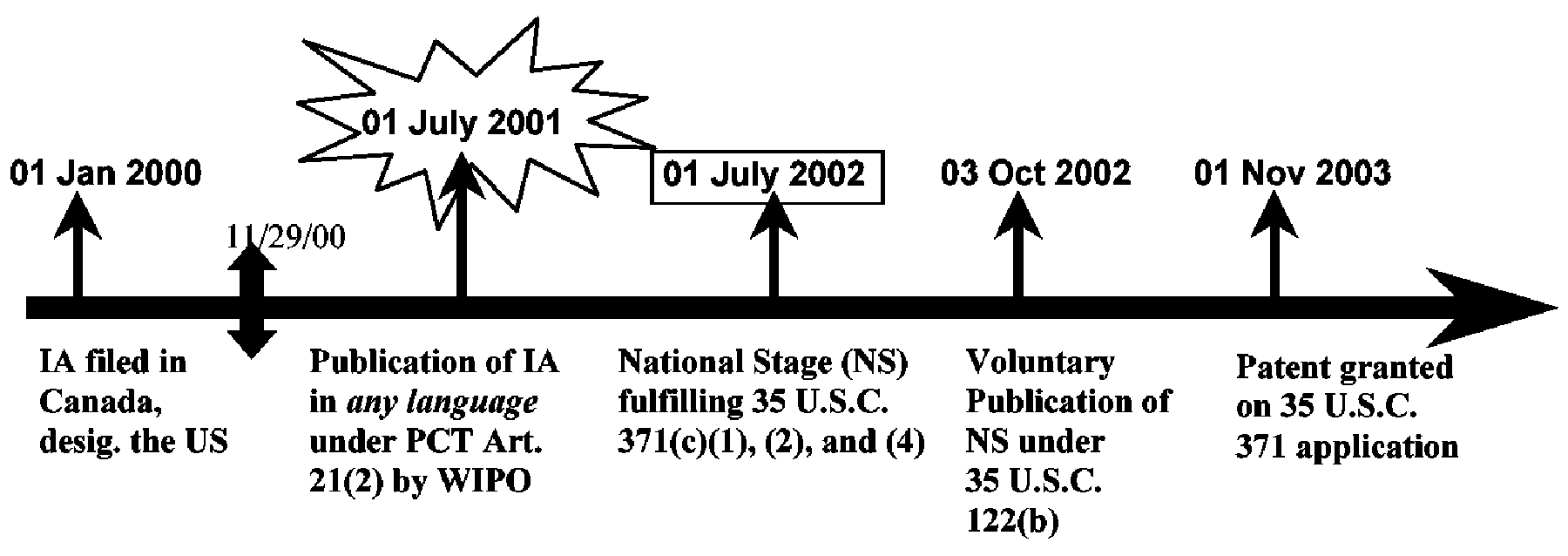
The 35 U.S.C. 102(e)(1) date for the IA Publication by WIPO is: None. The 35 U.S.C. 102(e)(1) date for the Publication by USPTO is: None. The 35 U.S.C. 102(e) date for the Patent is: 01 July 2002.
| The IA publication by WIPO can be applied under 35 U.S.C. 102 (a) or (b) as of its publication date (01 July 2001). |
| Additional * Benefit Claims : |
| If the IA properly claimed ** > the benefit of < any earlier-filed U.S. application (whether provisional or nonprovisional), there would still be no 35 U.S.C. 102 (e)(1) date for the U.S. and WIPO application publications, and the 35 U.S.C. 102 (e) date for the patent will still be 01 July 2002 (the date of fulfillment of the requirements under 35 U.S.C. 371 (c)(1), (2) and (4)). |
| If a later-filed U.S. nonprovisional ( 35 U.S.C. 111 (a)) application claimed the benefit of the IA in the example above, the 35 U.S.C. 102 (e)(1) date of the application publication of the later-filed U.S. application would be the actual filing date of the later-filed U.S. application, and the 35 U.S.C. 102 (e) date of the patent of the later-filed U.S. application would be 01 July 2002 (the date that the earlier-filed IA fulfilled the requirements of 35 U.S.C. 371 (c)(1), (2) and (4)). |
| If the patent was based on a later-filed U.S. application that claimed the benefit of the international application and the later filed U.S. application's filing date is before the date the requirements of 35 U.S.C. 371 (c)(1), (2) and (4) were fulfilled (if fulfilled at all), the 35 U.S.C. 102 (e) date of the patent would be the filing date of the later-filed U.S. application that claimed the benefit of the international application. |
| Example 7 : References based on a 35 U.S.C. 111 (a) Application which is a Continuation of an International Application , which was filed on or after November 29, 2000, designated the U.S. and was published in English under PCT Article 21(2) . |
| All references, whether the WIPO publication, the U.S. patent application publication or the U.S. patent of, or claiming the benefit of, an international application (IA) that was filed on or after November 29, 2000, designated the U.S., and was published in English under PCT Article 21(2) have the 35 U.S.C. 102 (e) prior art date of the international filing date or earlier effective U.S. filing date. No benefit of the international filing date (nor any U.S. filing dates prior to the IA), however, is given for 35 U.S.C. 102 (e) purposes if the IA was published under PCT Article 21(2) by WIPO in a language other than English. In the example below, it is assumed that the earlier-filed IA has proper support for the subject matter of the later-filed U.S. application as required by 35 U.S.C. 120 and 365 (c). |

The 35 U.S.C. 102(e)(1) date for the IA Publication by WIPO is: 01 Mar. 2001. The 35 U.S.C. 102(e)(1) date for the Publication by USPTO is: 01 Mar. 2001. The 35 U.S.C. 102(e)(2) date for the Patent is: 01 Mar. 2001.
| Additional * Benefit Claims : |
| If the IA properly claimed ** > the benefit of < an earlier-filed U.S. provisional ( 35 U.S.C. 111 (b)) application or the benefit of an earlier-filed U.S. nonprovisional ( 35 U.S.C. 111 (a)) application, the 35 U.S.C. 102 (e) date for all the references would be the filing date of the earlier-filed U.S. application, assuming the earlier-filed application has proper support for the subject matter relied upon as required by 35 U.S.C. 119 (e) or 120. |
| If a second, later-filed U.S. nonprovisional ( 35 U.S.C. 111 (a)) application claimed the benefit of the 35 U.S.C. 111 (a) application in the example above, the 35 U.S.C. 102 (e) date of the patent or publication of the second, later-filed U.S. application would still be the international filing date of the IA, assuming the earlier-filed IA has proper support for the subject matter relied upon as required by 35 U.S.C. 120 and 365(c). |
| Example 8 : References based on a 35 U.S.C. 111 (a) Application which is a Continuation of an International Application , which was filed on or after November 29, 2000 and was not published in English under PCT Article 21(2) . |
| Both the U.S. publication and the U.S. patent of the 35 U.S.C. 111 (a) continuation of an international application (IA) that was filed on or after November 29, 2000 but not published in English under PCT Article 21(2) have the 35 U.S.C. 102 (e) prior art date of the actual U.S. filing date of the 35 U.S.C. 111 (a) application. No benefit of the international filing date (nor any U.S. filing dates prior to the IA) is given for 35 U.S.C. 102 (e) purposes since the IA was published under PCT Article 21(2) in a language other than English. The IA publication under PCT Article 21(2) does not have a prior art date under 35 U.S.C. 102 (e)(1) because the IA was not published in English under PCT Article 21(2) . The IA publication under PCT Article 21(2) can be applied under 35 U.S.C. 102 (a) or (b) as of its publication date. |

The 35 U.S.C. 102(e)(1) date for the IA Publication by WIPO is: None. The 35 U.S.C. 102(e)(1) date for the Publication by USPTO is: 01 May 2003. The 35 U.S.C. 102(e)(2) date for the Patent is: 01 May 2003
| The IA publication by WIPO can be applied under 35 U.S.C. 102 (a) or (b) as of its publication date (01 Sept 2002). |
| Additional * Benefit Claims : |
| If the IA properly claimed ** > the benefit of < any earlier-filed U.S. application (whether provisional or nonprovisional), there would still be no 35 U.S.C. 102 (e)(1) date for the IA publication by WIPO, and the U.S. patent application publication and patent would still have a 35 U.S.C. 102 (e) date of the actual filing date of the later-filed 35 U.S.C. 111 (a) application in the example above (01 May 2003). |
| If a second, later-filed U.S. nonprovisional ( 35 U.S.C. 111 (a)) application claimed the benefit of the 35 U.S.C. 111 (a) application in the example above, the 35 U.S.C. 102 (e) date of the patent or publication of the second, later-filed U.S. application would still be the actual filing date of the 35 U.S.C. 111 (a) application in the example above (01 May 2003). |
| Example 9 : References based on a 35 U.S.C. 111 (a) Application which is a Continuation (filed prior to any entry of the national stage) of an International Application , which was filed prior to November 29, 2000 (language of the publication under PCT Article 21(2) is not relevant). |
| Both the U.S. publication and the U.S. patent of the 35 U.S.C. 111 (a) continuation (filed prior to any entry of the national stage) of an international application (IA) that was filed prior to November 29, 2000 have the 35 U.S.C. 102 (e) prior art date of their actual U.S. filing date under 35 U.S.C. 111 (a). No benefit of the international filing date (nor any U.S. filing dates prior to the IA) is given for 35 U.S.C. 102 (e) prior art purposes since the IA was filed prior to November 29, 2000. The IA publication under PCT Article 21(2) does not have a prior art date under 35 U.S.C. 102 (e)(1) because the IA was filed prior to November 29, 2000. The IA publication under PCT Article 21(2) can be applied under 35 U.S.C. 102 (a) or (b) as of its publication date. |
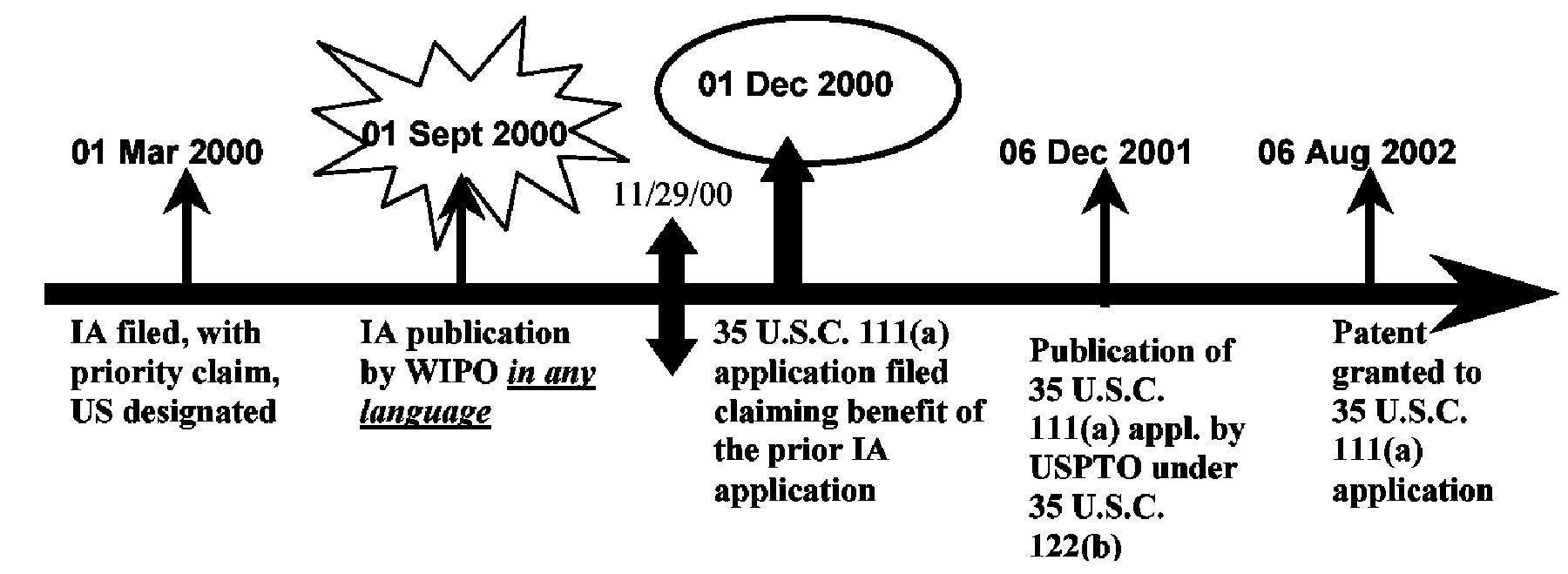
The 35 U.S.C. 102(e)(1) date for the IA Publication by WIPO is: None. The 35 U.S.C. 102(e)(1) date for the Publication by USPTO is: 01 Dec. 2000. The 35 U.S.C. 102(e)(2) date for the Patent is: 01 Dec. 2000.
| The IA publication by WIPO can be applied under 35 U.S.C. 102 (a) or (b) as of its publication date (01 Sept 2000). |
| Additional * Benefit Claims : |
| If the IA properly claimed ** > the benefit of < any earlier-filed U.S. application (whether provisional or nonprovisional), there would still be no 35 U.S.C. 102 (e)(1) date for the IA publication by WIPO, and the U.S. application publication and patent would still have a 35 U.S.C. 102 (e) date of the actual filing date of later-filed 35 U.S.C. 111 (a) application in the example above (01 Dec 2000). |
| If a second, later-filed U.S. nonprovisional ( 35 U.S.C. 111 (a)) application claimed the benefit of 35 U.S.C. 111 (a) application in the example above, the 35 U.S.C. 102 (e) date of the patent or publication of the second, later-filed U.S. application would still be the actual filing date of the 35 U.S.C. 111 (a) application in the example above (01 Dec 2000). |
III. FLOWCHARTS
**>